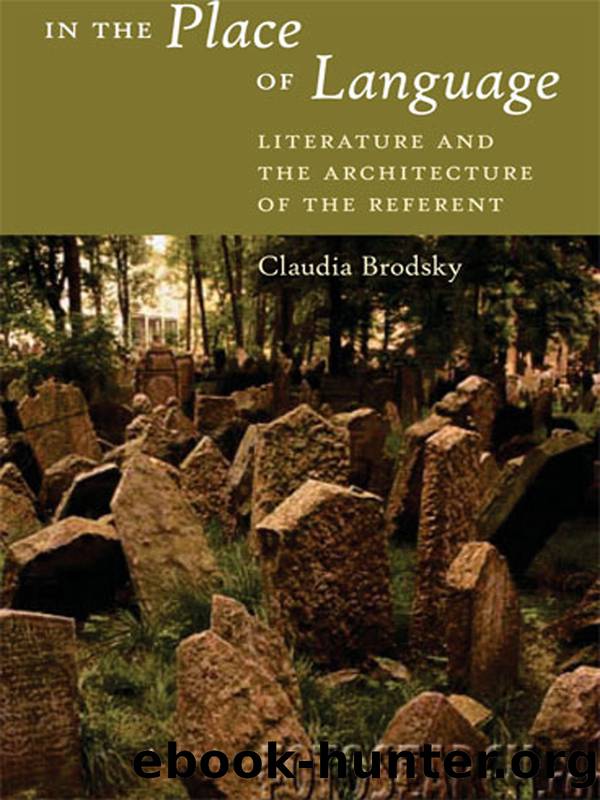In the Place of Language by Brodsky Claudia;

Author:Brodsky, Claudia;
Language: eng
Format: epub
Publisher: Fordham University Press
Published: 2009-08-15T00:00:00+00:00
AFTERWORD
Gravity: Metaphysics of the Referent
âGRAVEâ IS AN especially polysemous, formally versatile word in English, whose history of multiple meanings and grammatical functions betrays an unusually dense nexus or set of concepts when compared with the lexical differentiation of these in related, and relatively less hybrid, modern languages. Locative (dative case) descendant of the Old English graf or graff deriving from grafan, âto dig,â âgraveâ in Middle English designated the location of a specific object of digging, a âplace of burial,â the name of an action, in the form of a transitive verb, attributed to the end of that action, in the form of a substantive.1 By the thirteenth century, the nominal meaning of âgraveâ had extended significantly, from that of the particular piece of ground set aside for âthe reception of a corpseâ to any portion of ground instead appropriated by and passed on to the living. Spanning the substantive and categorical gaps between place and person, and past and present, this powerful, metonymic development encompassed both the particular plot of earth appropriated for the dead and âany person put in charge of propertyâ (thus âlandgrave,â âmargrave,â and the foreign language, Graf, or âcountâ) in its range of meaning.
In the fourteenth and fifteenth centuries, that semantic field expanded further into another register, as the physicalâspatial or humanââgraveâ was figuratively equated in popular and proverbial expressions with the essential definition (âturning in oneâs graveâ), end (âone foot in the graveâ), or incommunicability (âsecret as a graveâ) of the individual life. In pastoral, hymnal, and elegiac verse from Wycliffe through Gray, Wordsworth, and Shelley, âgraveâ came to stand not for the defining limit of life but for its opposite, the general âstate or condition of being dead,â or incumbent fact of âdeath,â linked to the experiences of living, if at all, by an adverbial prefix or postverbal marker of negation (Wordsworth, The Prelude, Bk. I, l.267: âUnprofitably traveling toward the graveâ; Shelley, âPreface to Alastor: âhe descends to an untimely graveâ and âThose who love not their fellow-beings live unfruitful lives, and prepare for their old age a miserable graveâ; Alastor, l.720: âBirth and the grave, that are not as they wereâ). Still in the fourteenth century, âgraveâ was used, in addition, to mean the artificial intersection of the living and the dead, the concrete representation, present to the living, of something no longer present but formally perfected: âthe graven image.â
While its nominal meanings developed, âgraveâ continued to change as a verb. Its limited earlier meaning, âdigââliterally expanded, in the eleventh century, to mean âdig out,â or âexcavateââincluded the notion of excavation both as historical uncovering and aesthetic formation, the partial removal of matter signified by âcarveâ and âengrave.â The placement of a body taking the place of the earth it displaces, and the artificial production of space as meaningful form appear the reversed or negative images of a single activity, as âgraveâ came to signify, in the thirteenth century, both âbury,â or âdeposit in the ground,â and ârecord by engraved or incised letters.
Download
This site does not store any files on its server. We only index and link to content provided by other sites. Please contact the content providers to delete copyright contents if any and email us, we'll remove relevant links or contents immediately.
Reading Colonial Japan by Mason Michele;Lee Helen;(334)
Phoenicians among Others: Why Migrants Mattered in the Ancient Mediterranean by Denise Demetriou(321)
The Roman World 44 BC-AD 180 by Martin Goodman(280)
DS001-THE MAN OF BRONZE by J.R.A(272)
Banned in the U.S.A. : A Reference Guide to Book Censorship in Schools and Public Libraries by Herbert N. Foerstel(270)
Verus Israel: Study of the Relations Between Christians and Jews in the Roman Empire, AD 135-425 by Marcel Simon(269)
The Dangerous Life and Ideas of Diogenes the Cynic by Jean-Manuel Roubineau(266)
Imperial Rome AD 193 - 284 by Ando Clifford(265)
Caesar Rules: The Emperor in the Changing Roman World (c. 50 BC â AD 565) by Olivier Hekster(258)
Introducing Christian Ethics by Samuel Wells and Ben Quash with Rebekah Eklund(251)
The Oxford History of World War II by Richard Overy(240)
Literary Mathematics by Michael Gavin;(239)
Infocracy by Byung-Chul Han(226)
Give Me Liberty, Seventh Edition by Foner Eric & DuVal Kathleen & McGirr Lisa(204)
How to Reach the 9.0 in IELTS Academic Reading by IELTS Medical(201)
The Compleat Victory by Kevin J. Weddle(190)
The Oxford History of the Renaissance by Campbell Gordon;(188)
The Manual of Photography by Elizabeth Allen & Sophie Triantaphillidou(182)
Language Hacking Mandarin by Benny Lewis & Dr. Licheng Gu(181)
